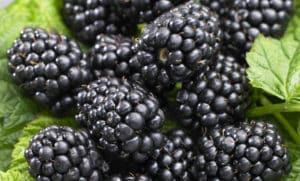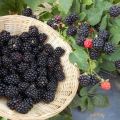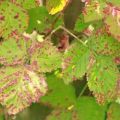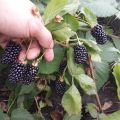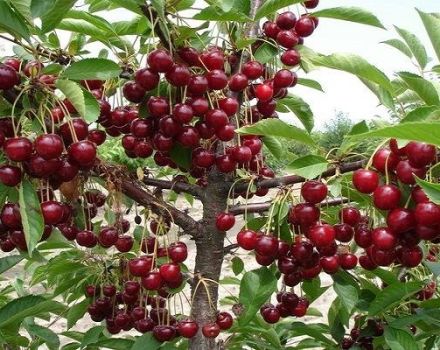Description and cultivation of Giant blackberries, care features
Judging by the few reviews of gardeners and advertisements for Becker Bis LLC products posted on the official website, the Giant blackberry variety has a lot of advantages, the main one of which is abundant yield. It is alarming that the stated description and photograph of the berry bush correspond to the Black Bute variety.
The article was written based on information from the forums and from the supplier's company page.
Description and characteristics of blackberries
Repaired blackberry varieties bred in America are distinguished by the presence of thorns. Blackberry Gigant is the only variety that combines remanufacturing with the absence of thorns.
The vine grows up to two meters, so the shoots need support. The decorativeness of a branchy and flexible shrub that blooms from the first days of summer to September is used in landscape design.
White flowers are large (4cm in diameter), like the fruit. If berries weighing 10 g are harvested from the bushes of large-fruited varieties, then berries weighing twice as much grow on the bushes of the Gigant variety. The length of the blue-black berries, ripening in July, reaches the size of the palm (6 cm), the shape is elongated, pyramidal, rounded at the end. The pulp is juicy, with a characteristic blackberry aroma.
The fruits have a balanced sweet and sour taste and a vitamin and mineral complex in composition that is not inferior to raspberries. The body's daily need for ascorbic acid is covered by 10 blackberries of the Gigant variety.
Fruiting, starting from the second year of the life of the culture, lasts from July to September. The plant is suitable for growing in regions with winter temperatures down to -30 ° C.
Fruits are included in the diet fresh, frozen or dried. Housewives use berries in cooking, cook compotes, preserves, jam, add to baked goods.
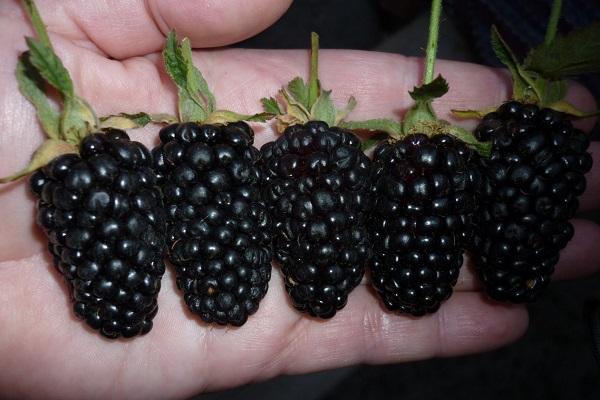
Advantages and disadvantages
Of the advantages of the Gigant variety, gardeners note:
- harvesting twice a season;
- abundant fruiting - up to 30–35 kg of berries per plant;
- undemanding care;
- frost resistance;
- lack of thorns, facilitating crop care;
- resistance to transportation, keeping the original appearance of the fruit;
- late flowering, preventing the death of buds from recurrent frosts;
- dessert taste;
- benefits to the body;
- universality of use;
- large berries.
The disadvantages of culture include the exactingness of irrigation.For the development of powerful shoots, ovary and the formation of juicy fruits, a lot of moisture is required, which the roots of the bush cannot provide on their own.
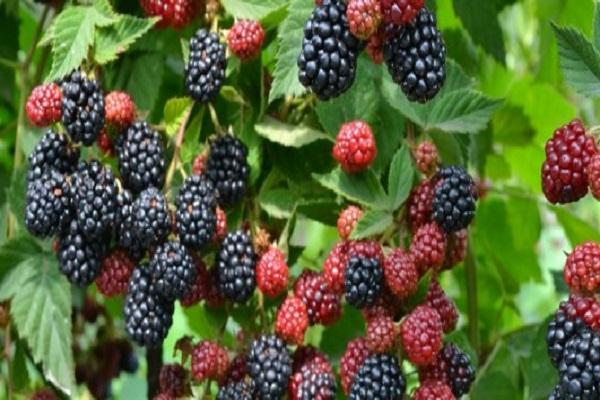
The specifics of growing the variety "Giant"
The pre-planting preparation of the land, the choice of the site, the seedling, the planting technology are quite simple and similar to the activities carried out with other varieties of large-fruited blackberries.
How to choose seedlings
It is recommended to choose an annual seedling with developed roots at least 10-15 cm long with a growth zone. Blackberry Giant is purchased on the Internet from a single supplier or from gardeners who have managed to propagate the culture.
A high-quality planting material should have two shoots 40-50 cm high with green leaves, intact without deformations, dry areas of the bark.
If the shoot under the bark is green, then the choice was made correctly. Brown color indicates that the bush is dry and should be discarded.
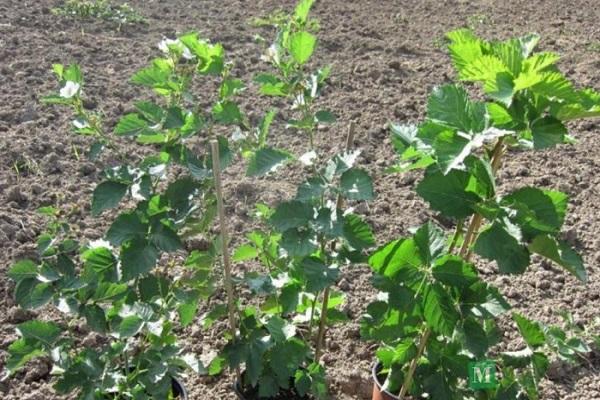
When is it better to plant
Blackberry varieties Gigant with an open root system are planted in March – April before the start of sap flow. Plants purchased in a container do well in the fall, a month before frost.
Selecting and preparing a landing site
Not suitable for growing blackberries are swampy areas, blown by the winds. The better the sunlight, the sweeter the fruits, although the culture develops well and bears fruit in partial shade. A suitable place is along the fence on the south side of the garden plot.
Blackberries of the Gigant variety are not planted in the place where plants belonging to the pink family were previously grown - raspberries, strawberries, rose bushes.
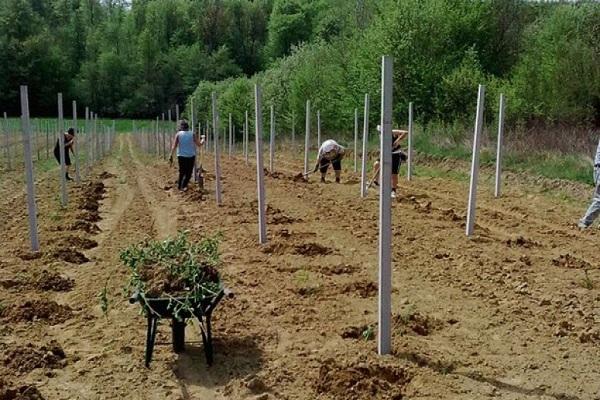
The culture does not impose special requirements on the soil, but it does not tolerate heavy, undrained substrates. The best option is fertilized slightly acidic loam.
The planting pit is prepared in advance, not less than a month in advance. If planting is planned for the spring, a pit for blackberries, half a meter deep and 40 cm wide, is dug in the fall.
The upper fertile layer is combined with half a bucket of compost, 15 g of potassium salt and superphosphate in an amount of 30 g.
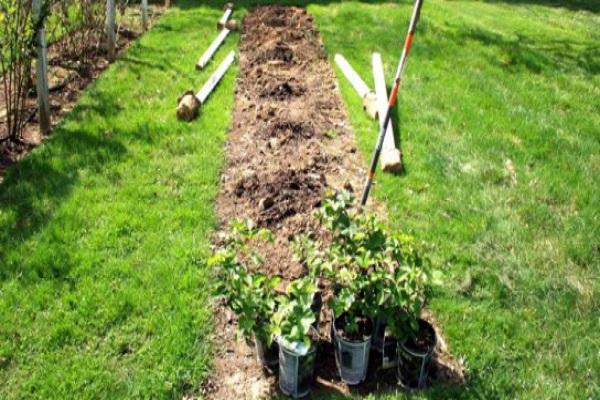
How to plant correctly?
If blackberries are planted near a fence or wall of a building, they retreat 1 meter away from them. A distance of at least two meters is maintained between the bushes. In the case of choosing a site not near the fence, first install a support next to the planting pit.
An hour before planting, the seedling is stimulated to root formation with the Kornevin preparation, by placing the shoot in a solution of the product.
Algorithm for planting blackberry varieties Gigant:
- roots are straightened in the pit, eliminating creases, wrong direction;
- fall asleep the plant gradually, shaking it periodically to avoid the formation of voids;
- the surface is compacted;
- make a near-stem groove, pour a bucket of water into it;
- place mulch around the seedling.
When planting, the root collar of a culture is buried into the ground by no more than 3 cm.
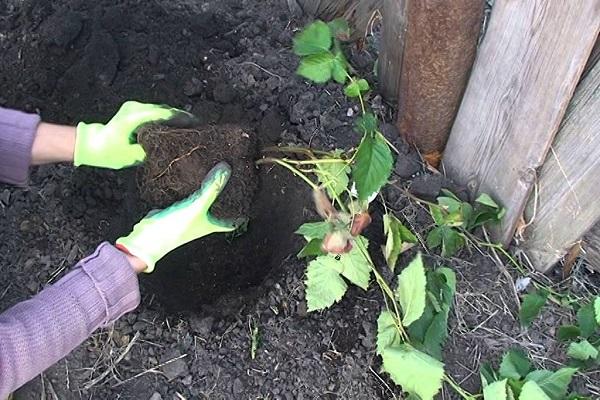
Blackberry care nuances
According to gardeners, caring for the Giant blackberry is not burdensome. Standard activities are carried out, including irrigation, feeding, garter vines. For full development, normal fruiting, the culture is protected from diseases and pests, winter frosts.
Watering regime and feeding rules
If the blackberry of the Gigant variety does not have enough moisture, the bushes shed flowers, an ovary or already formed berries. Plants of the first year of life especially need irrigation.
The culture is watered regularly, making sure that the topsoil does not dry out. It is recommended to spray the above-ground parts of the blackberry with moistening requirements with warm, settled water in the evenings in the summer, with insufficient precipitation.
Watering is suspended after the autumn harvest. The last time in the season they irrigate the bushes before the shelter for the winter.

Every fourth year, when planting blackberries, organic matter is introduced into the soil.
Watering mulch, including humus, peat, replenishes the soil with nutrients.If the bushes do not mulch, then complex mineral fertilizers (Ideal, Nitrofoska) are suitable as an alternative.
For flowering, the formation of ovaries, a mixture is used, consisting of:
- 2 tbsp. l. ammonium nitrate;
- 1 tbsp. l. potassium sulfate;
- 100 g of ammonium nitrate;
- half a bucket of humus.
It is useful to feed the culture with an ash solution prepared from a glass of ash and a bucket of water.

Garter bushes
The fragility of the shoots from the wind or the severity of the crop, the uneven illumination of the sun's rays forces gardeners to tie the Giant blackberry bushes.
The recommended and safe material for tying vines is twine made of nylon threads or polyethylene.
Several effective garter methods have been developed empirically:
- If one bush is grown, then a single support is enough - a solidly standing metal pillar.
- When tying with a bundle in the center of the bush, a stake is driven in, the vines are tied to each other, and tied to a support.
- The fan garter involves deepening the stake between young blackberry bushes and tying the extreme branches of neighboring bushes to it.
- With the trellis method, a structure is constructed consisting of pillars dug in every 3 m with two rows of wire transversely stretched (1 and 1.5 m from the ground).
When performing the event, it is recommended to tie up the blackberries so that the shoots are less in contact with the wire or twine due to the risk of damage to the bark.
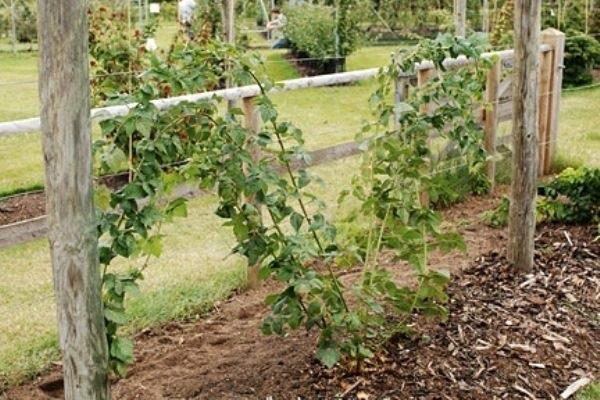
Preparing blackberries for the winter
The two-year growing season of the Gigant variety of blackberries involves pruning the fruiting branches of the current year after harvesting, which increases frost resistance. In addition to two-year-olds, weak shoots damaged by diseases and pests are cut out. Annuals are shortened by a quarter, leaving at least 1 cm above the upper bud.
Follow-up activities in preparation for winter include:
- getting rid of plant debris under the plant;
- pouring 30 liters of water under each bush for frost resistance of the root system;
- mulching bushes with sawdust, hay, peat;
- treatment with copper sulfate.
- release from the twine of the tied vines.
The blackberry is insulated after the first frost. Liana is tied in bunches, carefully bent down, fix the position with staples. There should be a layer between the ground and the shoots - boards, roofing felt, cardboard, mulch. From above, the culture is insulated with a covering material.

Treatment of plants from diseases and pests
Of the pests, the Giant blackberry is attacked by the following insect pests:
- raspberry and blackberry aphids;
- spider, raspberry, blackberry mites;
- weevil;
- caterpillars;
- stem gall midge.
To protect the culture from insects in the fall, the soil is spilled with Aktara's solution, in the spring the bushes are treated twice with Aktofit, Fitoferm or Akorin until the leaves appear. Effectively spraying blackberries with hot water on sleeping buds, wrapping the bushes with a film for 2 hours. It is recommended to remove fallen leaves, damaged parts of the culture, cut the shoots in the fall under the root, without leaving hemp.
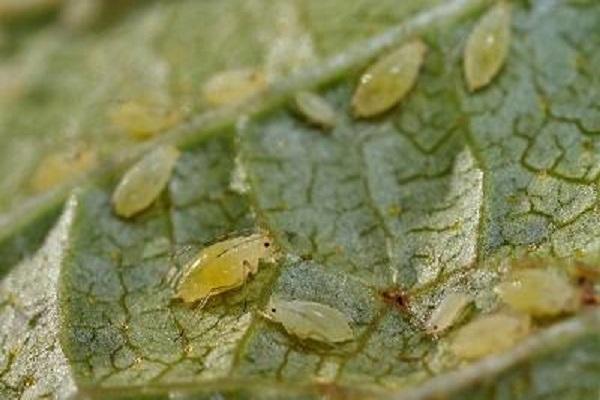
Of fungal diseases, the culture is affected by anthracnose, rust, and spotting. They fight diseases by treating the bushes with the preparations Fundazol, Topaz, Topsin M. Helps to prevent infection and the development of spores, preventive spraying in spring with Bordeaux liquid, sanitary pruning.
With a shortage or excess of microelements, different types of chlorosis appear in the culture, the structure of the leaf plates changes. The solution to the problem is rationing and timely feeding with complex mineral fertilizers.
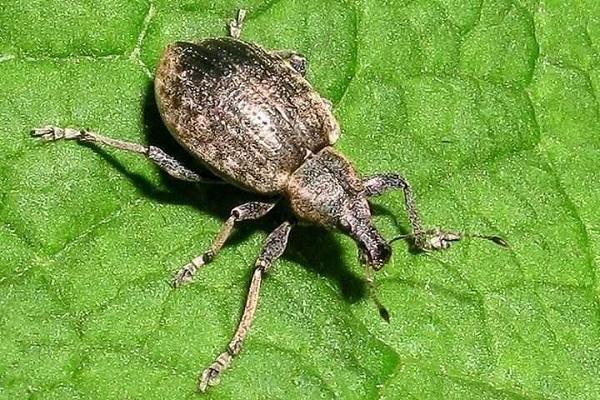
Breeding methods
Seed propagation of Gigant blackberries does not guarantee the preservation of varietal characteristics. Full fruiting occurs only after 5 years.
More often the culture is bred in vegetative ways, faster, more reliable:
- Layers
In August, lateral annual shoots are placed in pre-dug grooves.On both sides, the branches are fixed with hairpins, sprinkled with a substrate, without touching the top. Further, watered, mulched. Young plants are planted in a permanent place the next year in the spring.
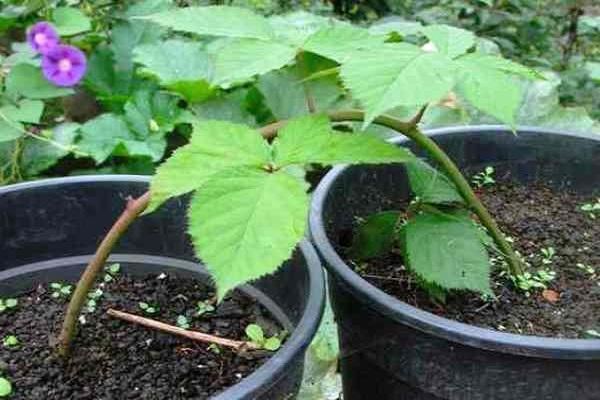
- Tops
The top of a 1.5-meter one-year-old blackberry shoot is bent down and buried in a hole 30 cm deep, folded into a ring or half ring. After a month, a root system is formed and young shoots appear. Before preparing for winter, the shoot of the mother plant is cut off, leaving a 30-centimeter cut. A full-fledged seedling is transplanted next spring.
- Cuttings
In autumn, cuttings 40 cm long are cut. Until spring, planting material is added to the soil. In April, the cuttings are planted one at a time at a distance of 10 cm from each other, pulling on top of the film, fixed on metal arcs.
In a greenhouse, plants develop until they grow on shoots of 3 leaves. The bushes are removed from the ground and planted one at a time in containers for growing.
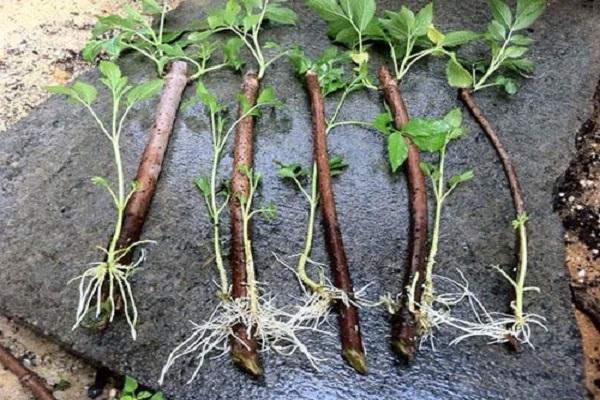
The blackberry Gigant is propagated by green cuttings taken from the tops in summer. The further algorithm of actions is the same as for stem cuttings. Or they take in the fall a 15-centimeter segment of a shoot with two buds, in the spring they put the cuttings in a glass, filling it with water, covering one sleeping bud. After spilling, an shoot with roots grows out of it, which is later transplanted into the ground.
- Offspring
In spring or autumn, strong root suckers 10–15 cm long are selected. They are dug in, the root is separated with a pruner from the mother plant, and immediately transplanted to a prepared place.
- By division
This method involves digging up a blackberry bush in autumn or spring, dividing the root into pieces with 2-4 shoots.
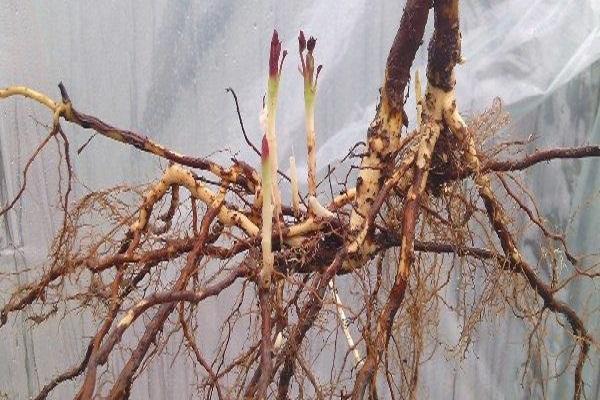
Harvesting and storage of crops
For own consumption, Giant blackberries are harvested fully ripe. Harvested in several stages from July to September in small containers that do not require shifting before processing. If transportation is planned, the fruits are picked a little unripe.
Unwashed, laid out in a container in one layer, the berries keep fresh in the refrigerator for up to four days.
The chemical composition of the fruits prepared for processing and whipped with a wooden spoon with sugar remains unchanged for up to three weeks.
Blackberries can be stored frozen for up to a year. The berries are dried, they make homemade preparations, liqueurs.
Blackberry Giant is a variety with ideal properties. Gardeners are attracted by fantastic yield, gigantic fruit size, winter hardiness, unpretentiousness to growing conditions.

